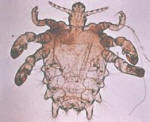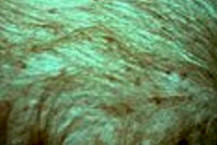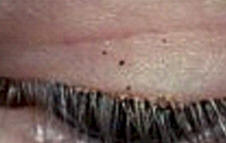
Pubic lice or "crabs"

Pubic lice in genital area

Public lice on eye-lashes
|
|
Pubic Lice
 Pubic lice or "crabs" |
 Pubic lice in genital area |
 Public lice on eye-lashes |
| Common Name | Pubic or Crab Louse |
|
| Scientific Name | Phthirus pubis | |
| Size | 1-2 mm | |
| Colour | Immediately after oviposition they are shiny, round and transparent | |
| Description | The dorso-ventrally flattened body of the louse is
divided into head, thorax and abdomen. A pair of eyes and a pair of
antennae are clearly visible on the head. The mouthparts are adapted to
piercing the skin and sucking blood. The second and third pair of legs,
with their terminal claws are adapted to holding the hair-shaft, while
the first pair of leg holds the skin during feeding. Abdominal
protuberances on the side of the body are characteristic of this
species. Males are slightly smaller than females. The eggs are
oval-shaped and ca. 0.8 mm in length. Immediately after oviposition they
are shiny, round, and transparent. Pubic lice are 1-2- mm in size,
varying according to the stage of their development. They are usually
whitish-grayish in color though they become reddish-brown for some time
after a blood-meal. Head Lice Head lice (Pediculus humanus capitis) are about the size of a
sesame seed, and can easily be seen, although they hide quickly when
exposed to light. Their eggs, called nits, are barely visible whitish
ovals cemented to hair shafts. Body Lice Body lice (Pediculus humanus corporis) look very much like those
found on the head, but are actually a different species. While they
aren’t as easily transmitted as head lice are, they are more difficult
to spot, hiding in the seams of clothing and folds of bedding when not
actually feeding. Public Lice Pubic lice (Phthirius pubis) are yellow-grey insects found in the
pubic region, and are typically spread during sexual contact. The size
of a pinhead, they are slightly translucent and barely visible against
light-coloured skin. With their shorter, rounder body shape and
crab-like claws with which they cling to hair, they resemble crabs –
hence their popular name. The eggs, which are barely visible, are tiny
white particles glued so firmly to hair shafts that they cannot be
removed by normal washing. |
|
| Habitat | Although any part of the body may be
colonized, crab lice favor the hairs of the genital (Fig. 1) and peri-anal
region. Especially in male patients, pubic lice and eggs can also be
found in hair on the abdomen (Fig. 2) and under the armpits as well as
on the beard and mustache, while in children they are usually found in
eye-lashes (Fig. 3). Infestation with pubic lice is called Phthiriasis
or Pediculosis pubis, while infestation of eye-lashes with pubic lice is
called Phthriasis palpebrarum. |
|
| Lifecycle | Pubic lice are insect parasites, spending their entire
life on the host's hair and skin and feeding exclusively on blood, 4-5
times daily. The life-cycle from egg to adult is 22-27 days. The egg
hatches producing the first nymphal stage, which after three moltings
develops to nymph 2, nymph 3 and subsequently to either a male or female
louse. The incubation period of the egg is 7-8 days, while the rest of
the cycle is taken up with the development of nymphal stages. The
average adult female lives for 17 and the male for 22 days. |
|
| Disease Transmitted | Several species of Culicoides spp are also important as
intermediary hosts of Onchocerca cervicalis, and as vectors of certain
viral diseases such as horse sickness in Africa. |
|
| Symptoms | The main symptom is itching, usually in the pubic hair
area. This itch is frequently worse at night. It results from
hypersensitivity to louse saliva, and it becomes strong enough two or
more weeks following initial infestation. Sometimes the bite can cause
an inflammatory skin reaction that is bluish gray in color. Although the
lice do not cause a rash, the constant scratching and digging can cause
the skin to become raw, and secondary infections can develop. In the majority of infestations a characteristic grey-blue or slate coloration appears (maculae caeruleae) at the feeding site, which may last for days and is also characteristic for the infestation. Pubic lice are primarily spread through sweat and body contact or sexual contact. Therefore, all partners with whom the patient has had sexual contact within the previous 30 days should be evaluated and treated, and sexual contact should be avoided until all partners have successfully completed treatment and are thought to be cured. Because of the strong association between the presence of pubic lice and classic sexually transmitted diseases (STD), patients diagnosed with pubic lice should undergo evaluation for other STDs. Infection in a young child or teenager may indicate sexual abuse. Head Lice: Body Lice: Pubic Lice: |
|
| Type of Damage | These parasites cause infection in humans that produces
dermatitis and skin lesions because the adult worms are located in the
skin. |
|
| Prevention | Prevention of head lice is difficult, especially among
children, since lice spread quickly from head to head. To help prevent
lice, prevent children from sharing hats, hooded coats, scarves, combs,
brushes, pillows, and soft toys. If you discover lice on your child,
notify school or day-care authorities immediately, since classmates are
likely to be infected. Infected children should be kept home from school
until they are treated. The best way to prevent lice in the genital area is monogamy or avoidance of intimate sexual contact. Condoms are not a good protection against lice because they do not cover the hairy areas where the lice live. You should also avoid contact with contaminated clothing, bed linen and toilet seats. Avoid sexual or intimate contact with infected people. If sexually active, use safer sex behaviours to avoid getting lice. Good personal hygiene is always recommended. If possible, avoid trying on bathing suits. However, if you must, be sure to wear your underwear while trying them on. This may prevent transmission. |
|
| Control |
Permethrin 1% cream rinse and pyrethrins can be used for this purpose
and are the drugs of choice for pregnant or lactating women. These
agents should be applied to the affected areas and washed off after 10
minutes. Shaving off or grooming any hair in the affected areas with a
fine-toothed comb is necessary to ensure full removal of the dead lice
and / or nits, though it does not suffice as treatment on its own.
Resistance of pubic lice to pyrethroids must be if at all very rare. A
second treatment after 10 days is recommended. Pubic lice on the
eyelashes can be treated with a permethrin formulation by applying the
solution to the infested hair with an applicator. It is dangerous to
remove lice or eggs in the eyelashes by plucking or cutting the hairs. Lindane shampoo (1%), a pediculocide, is FDA approved as safe and effective when used as directed for the second-line treatment of pubic lice (crabs). While serious side effects have been reported, they are considered to be rare and have almost always resulted from misuse of medication, such as excessive application and oral ingestion. To minimize this risk, Lindane medications are now dispensed in small single-use bottles. The Centers for Disease Control and Prevention (CDC) notes that lindane should not be used immediately after a bath or shower, and it should not be used by persons who have extensive dermatitis, women who are pregnant or lactating or children aged under 2 years. The FDA similarly warns against use in patients with a history of uncontrolled seizures disorders and premature infants, and recommends cautious use in infants, children, the elderly, and individuals with other skin conditions (e.g., atopic dermatitis, psoriasis) and in those who weigh less than 110 lbs (50 kg). Head Lice If you prefer to avoid the use of insecticides, try a "combing only" technique. Wash the hair with an ordinary shampoo and conditioner and leave wet. With a fine-toothed comb, stroke slowly outward from the roots through one lock of hair at a time. Lice will land on the back of the comb, get caught between the teeth, or fall off. Space at least 30 strokes over the head. Repeat every three days. Because new-born lice do not lay eggs for the first week, all lice should disappear after about two weeks of combing. Body Lice Pubic Lice |
|
[ Home Page ]